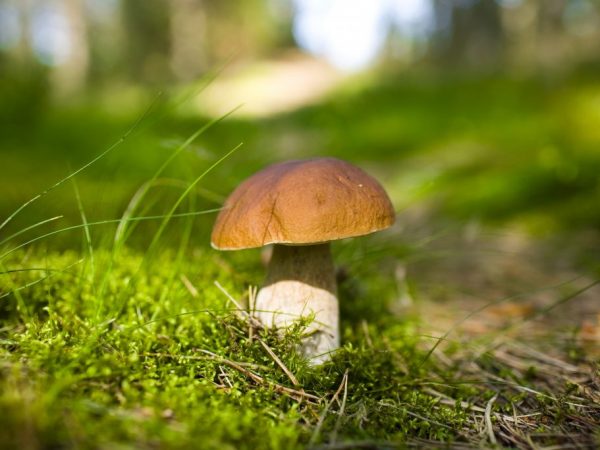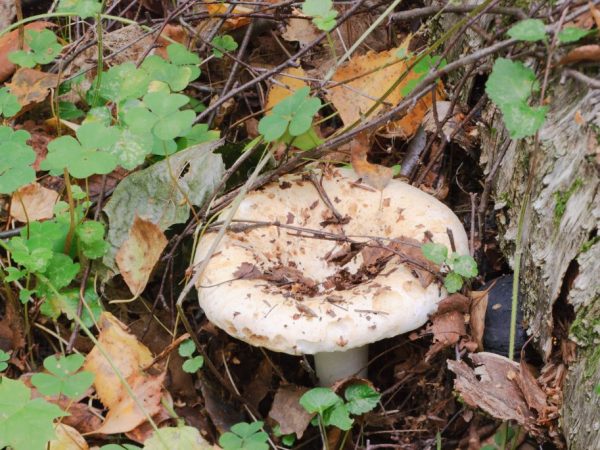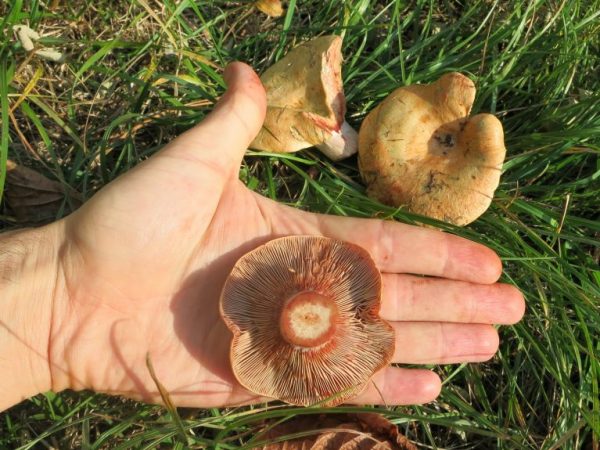Types of mushrooms and their characteristics
Mushrooms are a separate kingdom that has a huge variety of species that make up it. People use only a small number of them in cooking. Some varieties are used in medicine. To recognize valuable specimens, you need to know what types of mushrooms exist, how they look.
- Classification of mushrooms
- Edible varieties
- Boletus
- Oyster mushrooms
- Volnushki
- Chanterelles
- Butterlets
- Honey mushrooms
- Boletus (Redheads)
- Ryzhiki
- Conditionally edible mushrooms
- Milk mushrooms
- Zelenushki
- Morels
- Inedible mushrooms
- Differences between edible and inedible mushrooms
- Unusual varieties
- Medicinal varieties
- Mushrooms of the Red Book
- Conclusion

Types of mushrooms and their characteristics
Classification of mushrooms
The criterion of edibility was taken as the basis for the classification. The whole kingdom was divided into:
Edible: This includes those species that are suitable for consumption, even raw or dried. However, doctors recommend pre-subjecting them to heat treatment.
Conditionally edible: this group includes those species that are consumed only after prolonged heat treatment. They are soaked in water before cooking. Some types are boiled 2-3 times, changing the water each time. Also in this group are those mushrooms that are consumed if they are not overripe.
Inedible mushrooms: they are divided into hallucinogenic and poisonous. The former cause hallucinations after consumption, while the latter are deadly. If you consume a large amount of hallucinogenic mushrooms, a person risks dying. For collection, use and distribution hallucinogenic mushrooms criminalized... Hallucinations are images that arise in the mind of a person without the presence of the so-called. external stimulus. They are due to a special chemical composition, which includes muscarine, psilocybin, or psilocin.
Irina Selyutina (Biologist):
Poisonous mushrooms, in turn, are divided into groups depending on the degree of their danger to human health:
- Deadly Poisonous: are characterized by a pronounced plasmotoxic effect, because in its composition have the following toxic compounds: phalloidin, phalloin, phallocin, phallisin, amanitins, amanin, orellanin, etc. These include: pale grebe, gallerina bordered, stinking fly agaric, plush webcap.
- Mushrooms affecting nerve centers: they necessarily contain muscarine, muscaridin and other toxins with neurotropic action. This group includes: fiberfish, whitewashed govorushka, panther fly agaric, lemon fly agaric, pink mycena, etc. The effect of toxins is not fatal.
- Mushrooms with a local stimulating effect: the group includes the vast majority of species, the use of which causes mild poisoning with gastrointestinal disorders. Among them: sulfur-yellow false honey fungus, brick-red false honey fungus, ryadovka toad, etc. Poisoning by mushrooms belonging to this group is extremely rarely fatal.
There is another classification according to which mushrooms are:
- Tubular: these include those species, the underside of the cap of which resembles a fine-pored sponge.
- Plamellar: their inner (lower) side of the cap consists of thin plates.
In a separate group are truffles and morels, which are also called "snowdrops" mushrooms. This name was taught by morels due to the fact that they appear in the forests at the end of winter, along with the first forest flowers.
Soil mushrooms are of no interest to mushroom pickers, because are microscopic organisms.
Edible varieties
The variety of mushrooms suitable for consumption, fresh and dried, is amazing. The most popular are boletus (white), chanterelles, oyster mushrooms, boletus, honey agarics, aspen mushrooms, boletus and mushrooms. They are popular due to their excellent taste. All of them are often found on the territory of Russia. Less commonly, grouse, shimiji, cockerel, royal oyster (white steppe), orange aleuria, agaricus (a parasite that lives on the trunks of Siberian or Daurian larch), volvariel, mother-in-law's tongue, woodland (nutlet), royal spruce (spruce mushrooms) (grandfather's or grandfather's tobacco), green flywheel (sitovik), orange tremor, pink varnish and deer horns. The special attention of mushroom pickers is attracted by a group of mushrooms original in appearance, the so-called. Reindeer horns (coral hedgehogs, scallops or goat's leg). Their fruiting bodies resemble coral in structure. They have no poisonous counterpart.
Boletus
White mushroom (boletus) is the most popular member of the mushroom family. Due to its taste, it is considered the most valuable forest gift. On a thick leg there is a massive, porous cap on the underside, covered with a smooth skin. There are white, cream and light brown varieties, less often boletus, the cap of which is colored dark brown: this distinctive feature is due to the region of growth. The structure of the hymenophore is tubular. The pulp is white or creamy. The color at the cut site does not change. There is a light nutty aroma.
Depending on the type of forest in which the boletus grows, there are birch, pine and oak varieties. Each of them has excellent taste and is used in cooking.
Oyster mushrooms
A feature of oyster mushrooms is that they grow on trees and are considered wood-destroying mushrooms. Although most representatives of the fungal kingdom growing on trees are conditionally edible, oyster mushrooms are edible. A colony organism is a large number of thin flat-shaped caps, which are arranged in rows one above the other. The skin covering the caps, which look like small saucers, is colored gray. A special feature is that they are easy to grow at home. They will not grow on the ground, because are not saprophytes, and even more so - mycorrhiza formers. The substrate for them is prepared from wood and other components, or tree stumps are used. At a break, the color of the fruiting body remains unchanged.
In order for oyster mushrooms to produce a crop, they create conditions that are as close as possible to their natural habitat.
Volnushki

Waves taste good
Waves are white and pink. The pink variety is called rubella. Her hat is concave in the center, the edges are slightly bent outward. The diameter of the rounded cap, covered with a thin skin, is 6-8 cm. The fruiting body has a pleasant taste and a faint resinous odor. A white acrid milky juice appears on the cut. The wave grows in forests and glades, loves moss.
Chanterelles
Chanterelles got their name because of their bright yellow or gold color. On a cylindrical leg, which is slightly thicker at the top than at the bottom, there is a cap with a slightly depressed middle. The shape of the cap is irregular, the edges are uneven and wavy. White chanterelles also exist in nature, but they are rare.
Irina Selyutina (Biologist):
White chanterelle, or l. pale, or l.light is characterized by the presence in young specimens of smooth, downward-curving edges of the cap. As the fruiting body grows, a winding edge begins to form, but the bend decreases. This species differs from the rest of the cantarella species precisely in its color of the funnel-shaped cap - it is usually pale yellow or white and yellow. Even with a superficial examination, it becomes noticeable that the color is not uniform and resembles zonal spots. Chanterelle prefers deciduous forests, their areas where there is natural forest litter or there is moss and grass. The first fruiting bodies can be found in June. September ends the season for collecting the white chanterelle. According to the edibility classification, the pale chanterelle species belongs to category 2. According to its taste data, it is no different from ordinary (red) chanterelles.
Do not pick chanterelles in coniferous forests - specimens grown there usually taste bitter. The extract obtained from the fruiting body is used to get rid of worms.
Butterlets
In nature, there are many types of boletus, in particular m. Real, m. Cedar, m. Gray, m. White, m. Larch and m. Yellow-brown. The list of these varieties of tubular mushrooms goes on and on. They are all similar in appearance. The mushroom grows on sandy soils, chooses deciduous forests. The flat cap, colored light brown, has a tubercle. The thin skin, covered with sap of the mucous structure, can be easily separated from the fruiting body. The leg is cream colored.
Honey mushrooms
There are meadow, winter, summer and autumn varieties. They grow in groups. It will be possible to find mushroom groups - "families" next to trees and stumps. On a thin stem, there is a tubular rounded cap. Painted oil in cream and light brown. The leg is the same color as the hat and is decorated with a skirt.
Boletus (Redheads)
Aspen boletuses, or redheads, should be looked for, as folk wisdom says, next to aspens. A cap of the correct hemispherical shape is located on a thick and widened leg. The hat is colored cream, dark brown, rarely yellow. The leg, on which small dark scales are present, is white.
Ryzhiki
In coniferous forests, mushrooms grow. A concave cap is located on the cylindrical leg, resembling a funnel in shape. There is a coniferous smell, which the fruit pulp absorbs from the resin secreted by coniferous crops. A large number of fruits grow in the Ukrainian city of Liman (until 2016, Krasny Liman, Donetsk region).
Conditionally edible mushrooms
There are fewer conditionally edible varieties of mushrooms than edible ones. On the territory of Russia, milk mushrooms, greenfinches (green ryadovki), morels, serushki (serukhs), certain types of truffles and russula, some varieties of fly agarics are most often found. Rows grow in clusters, sometimes they form mushroom paths. Less common are otidea hare, pig (cow's lip, pork ears), pink wave, gray-pink fly agaric, motley barnacle (elk lip), “chicken” mushrooms (ringed cap) or yellow tinder fungi. The gray-pink fly agaric needs preliminary heat treatment at a temperature of at least 80 ° C in order to destroy the hemolytic rubescenslisin that is part of it and is dangerous to the body. This compound is capable of affecting blood cells - erythrocytes and leukocytes - to destroy their cell membranes. This compound is capable of manifesting its abilities upon direct contact with the blood.
Milk mushrooms

Milk mushrooms must be soaked before use.
In nature, milk mushrooms are divided into g. Yellow, g. White, g. Blue (spruce mushroom). They belong to the lamellar varieties, they have a depression in the center of the cap. The color of the cap varies depending on the variety. The taste contains bitterness due to the presence of pungent milky juice. Before heat treatment, they are soaked in water.
Zelenushki
Greenfinch stands out among other varieties in the pale green color of the cap and legs. The edges of the cap are down, the stem is long and slightly curved. There is a tubercle in the center of the cap. The color remains unchanged even after heat treatment, which was the reason for the apt folk name.
Morels
Morels have a thick leg, the cap has an unusual folded structure. Apothecia (fruiting bodies) in morels are large, usually at least 6-10 cm, fleshy, they clearly show a clear distinction into a leg and a cap - in color. The cap can be either ovoid or conical in shape, always with a network of longitudinal and transverse folds, often oblique. They form cells lined with hymenium (spore-forming layer), but the ribs separating them remain sterile. The edges of the cap grow together with the leg hollow inside.
Before consumption, morels are subjected to prolonged heat treatment.
Inedible mushrooms
This category should be bypassed. They cause death even when consumed in small quantities. The most dangerous are the pale toadstool, the red fly agaric and the satanic mushroom. Powerful hallucinogenic mushrooms include red fly agaric, blue-green stropharia, bell-shaped paneolus. Less common are bears' sawlifters, gebeloma, changeable pecica, panther fly agaric (panther), orange or orange-red cobweb, common line (“brain” mushroom), multicolored trametes (tinder fungus).
Differences between edible and inedible mushrooms
When going on a quiet hunt, you need to know the main differences between edible and inedible species:
- If mushrooms become blue, bright red or change color significantly at a break, most likely they belong to the poisonous group.
- A strong and unpleasant odor also indicates inedibility.
- Among all the representatives of poisonous mushrooms, many have a skirt on the leg - the remainder of a private blanket that covers the spore-bearing layer. This trait is not the main one; this element is also present in a number of edible specimens.
- During the cooking of poisonous fruit bodies, the water changes color, acquiring a blue or greenish tint. This is also inherent in some conditionally edible varieties due to the presence of hydrocyanic acid in their organisms, albeit in small quantities.
- On the caps of edible varieties, unlike inedible ones, specks are rarely present.
- The leg of poisonous mushrooms usually has at its base a well-pronounced tuberous thickening and a kind of sac surrounding it - a volva, the remainder of the common veil.
- Animals and insects bypass poisonous mushrooms, which is why their caps and legs often remain intact throughout the season.

Collect only mushrooms you know
It is worth putting in the basket those copies that are familiar.
Unusual varieties
There are varieties with an unusual appearance. These include a blue mushroom, a bleeding tooth (the mushroom body is covered with drops of a red compound), a lattice red mushroom, a bird's nest (mold), lycogala (wolf milk), a combed hedgehog, a giant bighead, a devil's cigar (a Texas star). Some of them are found everywhere, others grow in certain countries.
Sometimes groups of mushrooms grow in forests in the form of a circle, which is popularly called the "witch's circle". Previously, many associated a similar phenomenon with magic. Science has provided a logical explanation for this phenomenon. Sometimes the mycelium grows equally quickly in all directions. When the main fungus growing in the center dies, new ones grow along the edges of the mycelium, forming a circle and absorbing all nutrients from the soil. As a result of this, a circle with mushrooms growing along the edges (like a barrier of an arena) growing along the edges of it (like a barrier of an arena) is formed in a place very inaccessible to people.
Medicinal varieties
Ganoderma, maitake (curly griffin) or mutton mushroom, kombucha have medicinal properties. In oncology, the red camphor mushroom, which is also called camphor anthrodia, is widely used. It grows in Taiwan and is the property of the country. It contains substances that eliminate tumors. It not only helps fight cancer, but it also removes toxins.
The exotic species Iiitake (Japanese mushroom) is also of interest to physicians. It can be grown in a garden or greenhouse. Japanese and Chinese doctors have long known about its medicinal properties. At home, it is called the "elixir of youth" and is used to treat various diseases.
Black muer mushrooms growing on trees are also popular in the modern world. They are rarely found on the territory of Russia. The dried black fruiting bodies are like charred paper. Their use in cooking does not differ from the preparation of forest boletus. Black mushrooms taste like seafood.
Mushrooms of the Red Book
The Red Book includes a combed hedgehog (grandfather's beard). The body of the fungus is composed of many thin and long branches hanging downward. Shaggy hats grow on trees, they are painted white. After heat treatment, the chicken flavor appears on the dishes. It is not the only protected species. Under the ban for mushroom pickers are a girl's umbrella, an umbrella griffin, a blue gyroporos, a Bruma melanogaster, a chased honey fungus, a purple spider web (completely painted in purple), a pistil horn (with an externally missing hat, but having areas of the body intended for the development of spores), which are listed in the Red Book. , similar to a pistil), double mesh, edible sheep tinder fungus, deceptive trichia, ovoid fly agaric. The girl's umbrella on the hat has growths, which makes it seem prickly, and the umbrella griffin consists of a large number of small mushrooms on thin winding legs attached to thicker common legs. It is painted white or light gray.
There are also such varieties, on the edibility of which there is no exact data today, i.e. someone collects them and is happy, and someone cautiously walks by. These include the sarcoscifa bright red. These small mushrooms are shaped like deep red cups. The diameter of the bowl does not exceed 3 cm, which is why they are not of interest to mushroom pickers. Appear in forests in early spring.
The smallest mushroom in the world is a slime mold, and the largest grows in the United States and is called armillaria, or dark mushroom. Most of it is located underground (mycelium) and occupies about 900 hectares in the Malheur National Park, which is located in the east of Oregon.
Conclusion
Mushrooms are a large kingdom with a huge variety of species. Forest gifts are mushrooms, collected carefully so as not to put poisonous representatives of the group in the basket. They will appear after the spring rains. Previously, you should not go to the forest.


